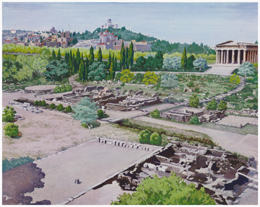Landscaping Ancient Agora in the 1950s. Before-and-After Photos

Ralph E. Griswold’s proposal of October 15, 1953 for the landscaping of the Ancient Agora of Athens
The Ancient Agora of Athens is considered by all, locals and tourists, to be a small oasis in the center of the city. Strolling in the largest archaeological park of Athens, in the shade of tall oaks, planes, and olives, we hardly realize how much effort was devoted to landscaping the site in the early 1950s. That was a major undertaking, one comparable to the reconstruction of the Stoa of Attalos itself. One only needs to see before-and-after photos in order to grasp the magnitude of this achievement.
The name of the architect eludes most visitors, even the learned: Ralph E. Griswold (1894-1981). Griswold was familiar with the Mediterranean landscape, having been a Fellow (1920-1923) and Resident Landscape Architect (1948-1949) at the American Academy in Rome (1948-1949). Because of his credentials, he was selected by the ASCSA in 1953 to draw up a plan for landscaping the Agora and to submit a budget. He and Homer Thompson, director of the Agora Excavations, “shared the same fundamental conviction… that the plants must all be native to Greece and so far as research could determine those plants which were known to the ancient Greeks and so likely to have grown in Athens in classical times” (Lucy Shoe Meritt, History of the American School of Classical Studies at Athens, 1939-1980, Princeton 1984, pp. 188-189). Griswold’s enthusiasm for the project was so great that he travelled throughout Attica, searching for trees and shrubs and soliciting advice from estate owners and farmers.
Our records in the ASCSA Archives also document that it was the Greek Colony of Toledo, Ohio that paid for Agora’s first tree in 1953 — a plane (πλατάνι) planted where Demosthenes’s statue once stood in antiquity.
Griswold’s preliminary report of 1953 is included among the Homer A. Thompson Papers in the School’s Archives and was recently digitized. Check out the before-and-after photos here. The end result was very similar to what Griswold had initially proposed.